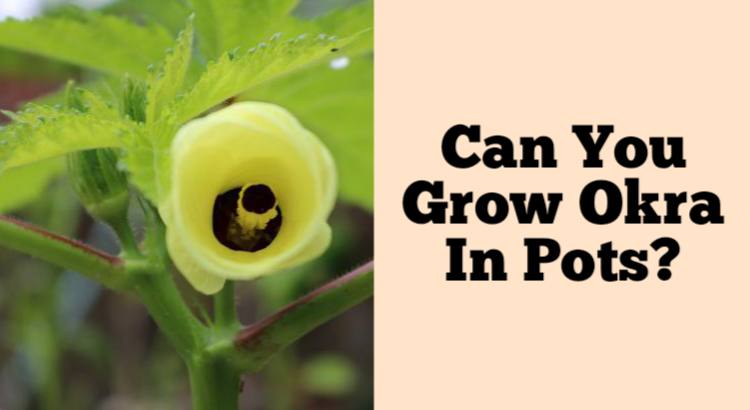Okra is a popular vegetable because it’s easy to grow and it tastes so good. You can grow okra from seeds or seedlings, but if you have limited space then growing them in pots might be the way to go.
Okra can be grown in containers as long as the container is large enough.
It’s possible to grow okra in a container. However, you should be aware that if you have a small pot and plant it too close to the edge of the pot, there’s a chance your okra will fall out of the pot because it grows so tall.
If you want to grow okra in containers, make sure you have large enough pots for them so that they don’t fall out or get pushed outside of them by their long roots.
Okra likes well-draining soil that has lots of compost mixed into it.
You should also add some fertilizer on a regular basis because this will help make your plants grow faster and bigger than they would otherwise do on their own without any extra nutrients added into their soil mix (which is usually just ordinary dirt).
When growing okra indoors, try not watering too much at once—especially when first planting seeds indoors.
For example: Don’t water twice daily because this can cause rot underneath where leaves meet stems; instead try watering once every three days (or even less often) until seedlings become established enough that they won’t need as much care anymore.
Does okra grow well in containers?
Okra is an annual plant, so it needs to be replanted each year. If you have a large enough container, however, you can grow okra in pots and keep them outdoors all summer long.
In order for okra to grow well in containers, you must take care not to overwater them or allow their soil to become soggy.
Okra likes hot weather and doesn’t require much water when grown indoors or outdoors in containers that are kept in the shade; otherwise its leaves will turn yellow due to sunburns on top surfaces of leaves (a condition known as “sun scald”).
However, the roots should still be watered regularly but not overly wet since this can cause root rot which can lead to death of your plants over time if left untreated by applying fungicide spray treatments with copper sulfate every two weeks during periods of high humidity.
Okra likes well draining soil.
Okra likes well-draining soil. It doesn’t like soggy, waterlogged soil or having its roots sitting in water. It does like to have its roots sitting in moist soil.
The best way to ensure that your plant has sufficient water is to check the soil first thing in the morning and again in the evening. If it feels dry, give it a little bit of water.
A good rule of thumb is that if you squeeze a handful of soil and can’t form a ball with it, it needs more water.
Okra grows best in hot, humid weather.
So if you live in the southern states of America, you’ve got it made. If you don’t have a greenhouse or a very large heated porch to grow your okra in, then it may be difficult to grow this vegetable from seedlings indoors.
The best time to start seeds indoors is about six weeks before your last frost date. Plant them about 1/2 inch deep and keep them moist until germination occurs.
Since okra plants can get quite tall (upwards of 6 feet) and need lots of heat, they need plenty of space between rows so they will not shade each other out as they grow taller every day during their peak growing season which lasts from June through September (or longer if temperatures remain high).
Okra likes to be watered regularly but not overly wet, so don’t overwater when growing okra in a container.
If you’re growing okra in a container, it’s important to water your plant regularly but not overly wet. The soil should be kept evenly moist, but not soggy. A couple good ways to tell if your okra needs more water are:
- Look at the top of the soil and see if it’s dry or moist
- Stick your finger into the soil up to ¼ inch deep and feel how damp it is there
Watering should be done in the morning so that by evening, any water evaporates from above ground level. This will keep insects like spider mites away from your plants.
How many okra plants per container?
Okra plants grow best when they’re spaced about 10 to 12 inches apart. That said, you can grow multiple okra plants in one container if you use a large enough container and space the plants sufficiently apart.
The number of plants per 5-gallon bucket will depend on how big your okras are. You might need to adjust the spacing or even add another layer of soil if they’re too crowded together.
If you don’t want to mess with that, just go ahead and add another layer of soil or mulch over them so they’re not directly touching each other.
The closer together they are, the more likely it is that their roots will compete for nutrients and water—and it’s harder for them to grow tall as well.
It also depends on whether you have free range chickens who love eating small green things like okra leaves.
If so then perhaps this isn’t such an issue – but if not then consider making sure there’s enough room between these two types of seedlings so that neither gets eaten before their time has come under threat from hungry birds.
Conclusion
With a little bit of planning, you can grow okra in containers like buckets or pots. As long as the container is large enough and well draining soil is used, you should be able to grow okra in any container.

